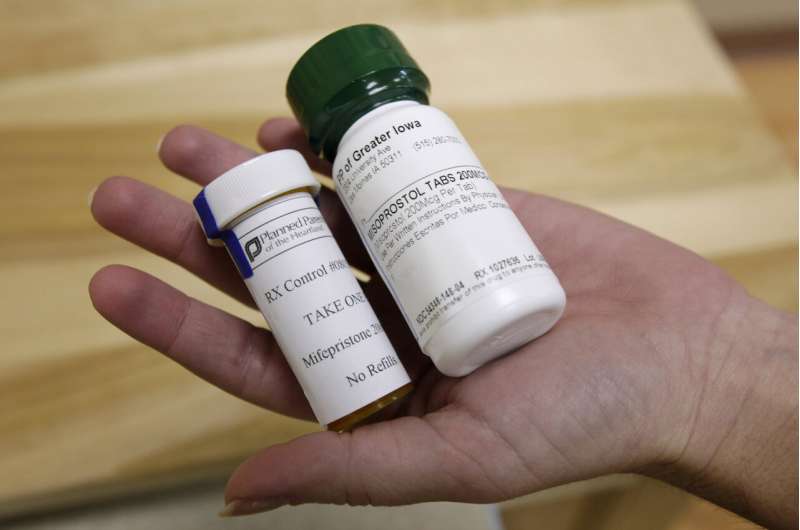This article has been reviewed according to Science X's editorial process and policies. Editors have highlighted the following attributes while ensuring the content's credibility:
fact-checked
reputable news agency
proofread
A common abortion pill will come before the US Supreme Court. Here's how mifepristone works

Medication abortion is the preferred method of ending pregnancy in the U.S., and one of the two drugs used—mifepristone—will now go in front of the U.S. Supreme Court next year.
Demand for the abortion pills mifepristone and misoprostol has grown as states have imposed bans or restrictions or seek to limit abortions after the reversal of Roe v. Wade in June 2022.
Conservative groups filed lawsuits targeting mifepristone, which is the only drug approved specifically for abortion, seeking to reverse its approval or rollback policies that have made it easier to obtain. The Supreme Court will hear a case in the spring that could block mail-order access to mifepristone and impose restrictions on its use, even in states where abortion remains legal.
The restrictions include shortening the window during pregnancy in which the drug can be used and requiring in-person office visits to get a prescription.
Here's a closer look at how mifepristone and misoprostol work and the legal challenges that the drugs face.
HOW DO ABORTION DRUGS WORK?
The prescription medications are taken several days apart.
Mifepristone is taken first, swallowed by mouth. The drug dilates the cervix and blocks the effects of the hormone progesterone, which is needed to sustain a pregnancy.
Misoprostol, a drug also used to treat stomach ulcers, is taken 24 to 48 hours later. The pill is designed to dissolve when placed between the gums and teeth or in the vagina. It causes the uterus to cramp and contract, causing bleeding and expelling pregnancy tissue.
While the two-drug combination is slightly more effective, misoprostol is sometimes used alone. That practice is more common in countries where mifepristone is banned.
HOW ARE ABORTION DRUGS ADMINISTERED?
Abortion medication is currently approved for use up to the 10th week of pregnancy.
The pills may be taken in a doctor's office or clinic, where patients sometimes have an ultrasound or lab tests beforehand. Some providers also offer the pills through telehealth visits and send the medication by mail.
The pills account for more than half of all U.S. abortions.
WHAT ARE THE SIDE EFFECTS?
Studies and real-use evidence show that when taken together, the pills are safe and up to 99% effective.
Side effects may include nausea, vomiting and diarrhea. Bleeding is normal; very heavy bleeding is uncommon and requires medical attention.
Serious complications are very rare. The U.S. Food and Drug Administration said last year about 5.9 million women have used mifepristone since it was approved more than 20 years ago. The agency has received 32 reports of deaths in women using the medication, including two involving ectopic pregnancies, which grow outside the womb. The deaths can't be definitively attributed to mifepristone because in many cases the women had other health conditions and were using other medications.
The medications are not recommended for certain patients, including those with suspected ectopic pregnancies or with implanted IUD birth control devices.
Dr. Stephanie Rand, a New York OB-GYN and abortion specialist with the advocacy group Physicians for Reproductive Health, says pregnancy tests should not be used right away to determine if a medication abortion was successful because the pregnancy hormone may linger in the body for several weeks. Bleeding with blood clots that include lighter colored tissue are signs of success, she said.
HOW MUCH DOES MEDICATION ABORTION COST?
It varies by location, but it's similar to abortion procedures and may total more than $500. Health insurance coverage also varies, with some plans making the pills free or low-cost and others not covering them at all.
Mifepristone is sold under the brand name Mifeprex and misoprostol under the brand name Cytotec. Both pills are available as generics.
WHAT'S THE LEGAL STATUS OF MIFEPRISTONE?
Mifepristone remains fully approved, despite the legal challenges. The FDA and the Biden administration have reiterated that the drug's safety and effectiveness have been repeatedly confirmed by multiple studies conducted since its 2000 approval.
Access largely depends on where a patient lives. Currently, 14 states are enforcing laws that bar abortions, including medication abortions, throughout pregnancy. Another 15 states have separate laws specifically limiting how mifepristone can be prescribed and distributed, such as requiring an in-person visit with a physician.
Still, some women in states with bans are able to obtain the pills through the mail, which isn't tightly regulated.
The case now before the Supreme Court began with a legal challenge in 2022 by Christian conservatives who sought to overturn mifepristone's original FDA approval. A Texas judge sided with the group in an initial victory that would have required the drug to be removed from the market. But an appeals court left the drug's approval intact, instead issuing a ruling that would reverse changes the FDA made in 2016 and 2021 that eased access to the drug.
The Supreme Court put all those changes on hold while it considers the case.
HOW COULD THE SUPREME COURT'S RULING IMPACT ACCESS?
If the justices side with abortion opponents, it would likely mean the drug could no longer be sent through the mail as has been possible since 2021. It would also shorten the window for use to seven weeks from 10 weeks—the latter was approved in 2016.
Other requirements would include reimposing three in-person office visits with a doctor before women could get a prescription. Additionally, women also might have be required to take a higher dosage of the drug than the FDA says is necessary. That's because a negative ruling would also overturn a determination by the FDA that a lower dosage could be safely used.
The U.S. Supreme Court is likely to decide on the case by late June.
© 2023 The Associated Press. All rights reserved. This material may not be published, broadcast, rewritten or redistributed without permission.



















